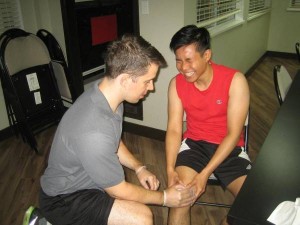Joint effusion is defined by excess fluid in a joint. It might be brought about by infection, injury or a medical condition.
What are the signs?
Generally, only one knee is affected by joint effusion. There is also heaviness in the joint and it appears puffed up than the other knee.
Other signs and symptoms that might be present include:
- Redness and swelling of the skin bordering the kneecap
- Rigidity of the joint and difficulty straightening or flexing the leg
- Tenderness and pain especially if weight is placed on the joint
Generally, only one knee is affected by joint effusion. - The joint feels warmer than the opposite knee
Joint effusion will make it difficult to walk, climb stairs or perform daily activities.
What are the causes?
Some of the possible causes of water buildup in the knee include:
- Overuse or repetitive injury
- Fracture
- Torn ligament or cartilage
- Bacterial infection
- Prepatellar bursitis
- Gout or pseudogout
- Osteoarthritis or rheumatoid arthritis
- Tumors or cysts
Management of joint effusion
The treatment for joint effusion is based on the cause. Some of the commonly-used treatment options include:
- Pain medications and anti-inflammatory drugs
- Antibiotics if infection is present
- Oral corticosteroids or shots directly into the joint
- Joint aspiration to briefly lessen the pressure followed by a shot of corticosteroid
- Arthroscopy
- Physical therapy to improve flexibility and establish strength of the muscles around the joint
In case the knee joint does not respond to other treatment options, surgical removal of the bursa sac is needed. In severe cases, knee replacement is an option.

